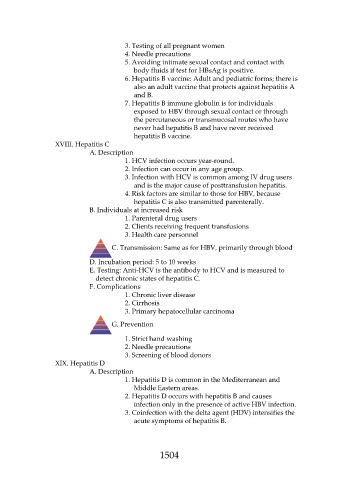Page 1504 - Saunders Comprehensive Review For NCLEX-RN
P. 1504
3. Testing of all pregnant women
4. Needle precautions
5. Avoiding intimate sexual contact and contact with
body fluids if test for HBsAg is positive.
6. Hepatitis B vaccine: Adult and pediatric forms; there is
also an adult vaccine that protects against hepatitis A
and B.
7. Hepatitis B immune globulin is for individuals
exposed to HBV through sexual contact or through
the percutaneous or transmucosal routes who have
never had hepatitis B and have never received
hepatitis B vaccine.
XVIII. Hepatitis C
A. Description
1. HCV infection occurs year-round.
2. Infection can occur in any age group.
3. Infection with HCV is common among IV drug users
and is the major cause of posttransfusion hepatitis.
4. Risk factors are similar to those for HBV, because
hepatitis C is also transmitted parenterally.
B. Individuals at increased risk
1. Parenteral drug users
2. Clients receiving frequent transfusions
3. Health care personnel
C. Transmission: Same as for HBV, primarily through blood
D. Incubation period: 5 to 10 weeks
E. Testing: Anti-HCV is the antibody to HCV and is measured to
detect chronic states of hepatitis C.
F. Complications
1. Chronic liver disease
2. Cirrhosis
3. Primary hepatocellular carcinoma
G. Prevention
1. Strict hand washing
2. Needle precautions
3. Screening of blood donors
XIX. Hepatitis D
A. Description
1. Hepatitis D is common in the Mediterranean and
Middle Eastern areas.
2. Hepatitis D occurs with hepatitis B and causes
infection only in the presence of active HBV infection.
3. Coinfection with the delta agent (HDV) intensifies the
acute symptoms of hepatitis B.
1504

